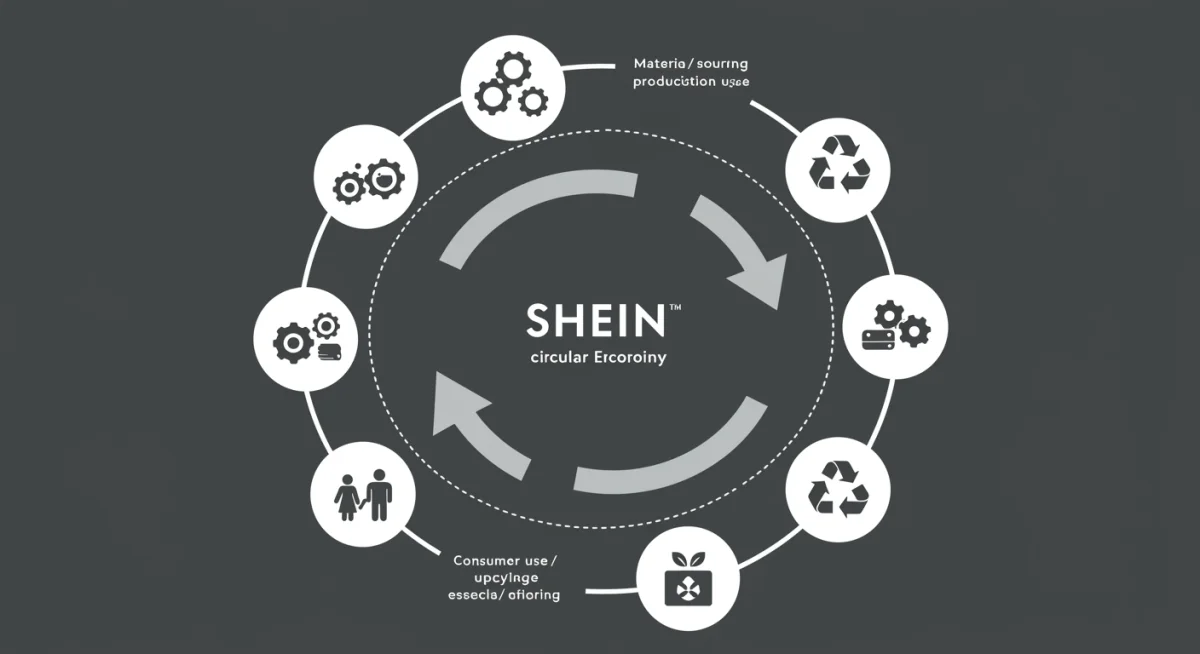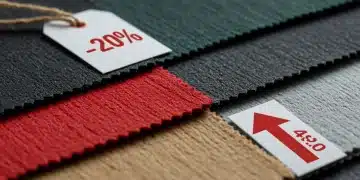Shein’s Sustainability Report: 15% Waste Reduction by 2025

Anúncios
Shein’s new sustainability report details an ambitious plan to achieve a 15% reduction in waste by 2025, emphasizing enhanced material efficiency and responsible production practices across its global supply chain.
The global fashion giant Shein has just released its latest sustainability report, a document keenly awaited by industry observers and environmental advocates alike. This report unveils a significant commitment: a targeted 15% reduction in waste by 2025. This ambitious goal marks a pivotal moment for the fast-fashion behemoth, signaling a more concentrated effort towards environmental stewardship.
Anúncios
Understanding Shein’s Sustainability Commitment
Shein’s new sustainability report outlines a multifaceted approach to reducing its environmental footprint. This commitment extends beyond mere rhetoric, delving into tangible strategies designed to optimize resource use and minimize waste across its extensive operations.
For years, fast fashion has been under scrutiny for its environmental impact, particularly concerning waste generation. Shein, as a leading player, faces immense pressure to innovate and demonstrate genuine progress. This report aims to address those concerns head-on, setting clear, measurable targets for the coming years.
Anúncios
The Drive for Material Efficiency
A core pillar of Shein’s strategy involves improving material efficiency. This means optimizing fabric utilization, reducing cutting waste, and exploring alternative, more sustainable materials.
- Fabric Optimization: Implementing advanced pattern-making software to minimize textile offcuts.
- Sustainable Sourcing: Increasing the use of recycled polyester, organic cotton, and other eco-friendly fibers.
- Digital Printing: Shifting towards digital printing technologies that consume less water and generate less dye waste.
These initiatives are crucial for a company operating at Shein’s scale, where even small improvements can lead to substantial environmental benefits. The focus on material efficiency is a proactive step towards a more circular production model.
Supply Chain Collaboration for Waste Reduction
Shein acknowledges that achieving its waste reduction goals requires extensive collaboration throughout its supply chain. The report details plans to work closely with suppliers, manufacturers, and logistics partners to identify and implement sustainable practices.
This collaborative approach is essential for tackling waste at every stage, from raw material extraction to product delivery. By fostering stronger partnerships, Shein aims to create a more resilient and environmentally responsible supply chain. The company plans to offer training and incentives to partners who adopt greener practices, ensuring a shared commitment to sustainability.
Ultimately, Shein’s sustainability commitment reflects a growing awareness within the industry of the urgent need for change. The 15% waste reduction target for 2025 represents a concrete step in this direction, signaling a strategic shift towards more responsible business practices.
Key Strategies for Achieving the 15% Waste Reduction Target
Achieving a 15% waste reduction by 2025 is an ambitious undertaking for a company of Shein’s size. The report details several key strategies that will underpin this effort, focusing on innovation, process optimization, and enhanced resource management.
These strategies are designed not only to meet the reduction target but also to embed sustainable practices deeper into Shein’s operational DNA. The company is investing in technology and infrastructure to support these goals, recognizing that long-term sustainability requires significant upfront commitment.
Innovations in Production Processes
Shein is exploring various technological innovations to streamline its production processes and minimize waste. This includes leveraging artificial intelligence and data analytics to predict demand more accurately, thereby reducing overproduction.
- AI-Driven Demand Forecasting: Utilizing AI to better anticipate consumer trends and order quantities, preventing excess inventory.
- On-Demand Manufacturing: Exploring models that allow for smaller, more precise production runs based on real-time orders.
- Automated Cutting Systems: Implementing advanced machinery that optimizes fabric layouts to reduce scrap material.
These technological advancements are pivotal in transforming traditional manufacturing into a more responsive and resource-efficient system. By minimizing overproduction, Shein can significantly cut down on unsold inventory that would otherwise become waste.
Circular Economy Initiatives
A significant portion of Shein’s waste reduction strategy revolves around embracing circular economy principles. This involves designing products for longevity, enabling repair, and facilitating recycling or upcycling at the end of a garment’s life.
The transition to a circular model is complex but offers immense potential for waste reduction. Shein is beginning to explore pilot programs for garment collection and textile recycling, aiming to give old clothes a new life rather than sending them to landfills. This includes partnerships with textile recycling innovators and exploring new material science.

Furthermore, Shein is looking into design practices that enhance product durability, extending the lifespan of garments. This counteracts the traditional fast-fashion model of rapid consumption and disposal, promoting a more sustainable lifecycle for its products. The report highlights the importance of consumer education in supporting these circular efforts.
The strategies outlined by Shein demonstrate a clear intention to move towards more sustainable practices. While challenging, these initiatives are crucial for the company’s long-term environmental viability and its commitment to responsible fashion production.
The Impact of Waste Reduction on the Fast Fashion Industry
Shein’s commitment to a 15% waste reduction by 2025 has significant implications for the entire fast fashion industry. As a market leader, its actions can set new benchmarks and inspire other brands to follow suit, fostering a ripple effect of positive environmental change.
The sheer volume of production in fast fashion means that even incremental improvements in waste management can lead to massive reductions in overall environmental impact. This move by Shein could accelerate the adoption of more sustainable practices across the sector.
Setting New Industry Standards
When a major player like Shein announces such an ambitious goal, it inevitably pushes other companies to re-evaluate their own sustainability efforts. This competition to be greener can lead to faster innovation and wider adoption of best practices.
The industry has long been criticized for its linear ‘take-make-dispose’ model. Shein’s report signals a shift towards a more circular approach, which could become a new standard. This pressure from within the industry, coupled with increasing consumer demand for sustainable products, is creating a powerful impetus for change.
Challenges and Opportunities for Other Brands
While Shein’s announcement presents an opportunity for industry-wide improvement, it also highlights the significant challenges involved. Smaller brands may struggle to implement similar large-scale changes without the same resources.
However, it also opens doors for collaboration and shared learning. The development of new technologies and sustainable materials by larger companies can benefit the entire industry. This can foster an ecosystem where sustainability becomes a collective goal rather than an individual burden.
Ultimately, Shein’s waste reduction target serves as a powerful reminder that sustainability is no longer optional but a critical component of modern business strategy in the fast fashion landscape. Its success, or lack thereof, will be closely watched and will undoubtedly influence future industry trends.
Consumer Expectations and Shein’s Transparency Efforts
In today’s market, consumers are increasingly demanding transparency and accountability from brands, especially regarding environmental and social practices. Shein’s new sustainability report addresses these expectations by providing detailed insights into its waste reduction goals and methodologies.
This shift towards greater transparency is crucial for building consumer trust and loyalty. Brands that openly communicate their efforts and challenges in sustainability are more likely to resonate with environmentally conscious shoppers.
Building Trust Through Disclosure
The report serves as a vital communication tool, offering consumers a clear understanding of Shein’s environmental commitments. By publishing specific targets and progress metrics, Shein aims to demonstrate a genuine dedication to sustainability.
- Clear Targets: Stating a precise 15% waste reduction goal by 2025.
- Methodology Explained: Detailing the strategies and technologies used to achieve these targets.
- Regular Updates: Committing to periodic reports on progress, ensuring ongoing accountability.
This level of detail helps to counter skepticism often directed at fast fashion brands, providing concrete evidence of their efforts. Transparency also allows for external scrutiny, which can further drive improvement.
Addressing Greenwashing Concerns
One of the biggest challenges for brands in communicating sustainability is avoiding accusations of greenwashing – making misleading claims about environmental practices. Shein’s report attempts to mitigate these concerns through its detailed and measurable commitments.
By focusing on specific, quantifiable goals like waste reduction, Shein provides tangible proof of its intentions. This contrasts with vague or aspirational statements that often characterize greenwashing. The report also highlights the complexities of achieving sustainability in a global supply chain, acknowledging that it is an ongoing journey.
Shein’s efforts to enhance transparency are a strategic move to align with evolving consumer values. By openly sharing its sustainability journey, the company hopes to foster greater trust and demonstrate its commitment to responsible business practices.
Technological Innovations Driving Waste Reduction
The ambitious waste reduction target set by Shein is heavily reliant on the adoption and integration of cutting-edge technological innovations. These advancements are not merely supportive but are foundational to transforming traditional manufacturing and supply chain processes into more sustainable models.
Technology offers unprecedented opportunities to optimize resource use, minimize material waste, and streamline operations in ways that were previously unimaginable. Shein’s investment in these areas underscores a forward-thinking approach to sustainability.
AI and Data Analytics for Precision Manufacturing
Artificial intelligence (AI) and advanced data analytics play a crucial role in Shein’s strategy to reduce waste. By leveraging these technologies, the company can achieve a level of precision in production that significantly cuts down on excess materials and unsold inventory.
AI algorithms can analyze vast datasets of consumer preferences, historical sales, and real-time trends to forecast demand with remarkable accuracy. This enables Shein to produce garments in quantities that closely match actual demand, thereby minimizing overproduction and the associated waste of materials and resources. Furthermore, data analytics can identify inefficiencies in the supply chain, pinpointing areas where waste can be further reduced.
Advanced Material Science and Recycling Technologies
Beyond optimizing production, Shein is also exploring advancements in material science and recycling technologies. This includes the development and integration of new fabrics that are either more sustainable in their production or easier to recycle at the end of their lifecycle.
Innovations in textile recycling, such as chemical recycling methods that can break down fabrics into their original monomers, offer promising pathways for creating closed-loop systems. Shein’s report suggests a commitment to exploring these emerging technologies, which could revolutionize how textile waste is managed. This involves investing in research and development, as well as partnering with specialized recycling firms to scale these solutions.
The integration of technology is not just about efficiency; it’s about fundamentally rethinking how fashion is produced and consumed. Shein’s focus on technological innovation demonstrates a clear understanding that sustainable transformation requires a deep commitment to modern solutions.
Future Outlook: Beyond 2025 and Long-Term Goals
While the 15% waste reduction target by 2025 is a significant short-term goal, Shein’s sustainability report also hints at a broader, long-term vision. This forward-looking perspective is crucial for establishing genuine and lasting environmental stewardship within the company.
Sustainability is not a destination but an ongoing journey. Shein’s report suggests that the 2025 target is merely an initial milestone in a much larger commitment to a more responsible and circular business model.
Expanding Circularity and Resource Management
Beyond 2025, Shein aims to further integrate circular economy principles into every aspect of its operations. This includes exploring advanced take-back programs for garments, expanding repair and resale initiatives, and investing in infrastructure for large-scale textile recycling.
- Product Longevity: Designing clothes with greater durability and timeless appeal to extend their lifespan.
- Recycling Infrastructure: Investing in facilities and partnerships to process post-consumer textile waste more effectively.
- Renewable Energy Use: Gradually transitioning to renewable energy sources across its operations and supply chain.
These long-term goals indicate a strategic shift towards a business model that prioritizes resource preservation and minimizes environmental impact throughout the entire product lifecycle. The company understands that true sustainability requires systemic change.
Collaborative Industry Transformation
Shein recognizes that no single company can solve the fashion industry’s environmental challenges alone. The report emphasizes the importance of continued collaboration with industry stakeholders, including NGOs, policymakers, and other brands, to drive collective progress.
This collaborative approach is vital for sharing best practices, developing common standards, and advocating for supportive policies that accelerate the transition to a more sustainable fashion ecosystem. Shein’s long-term vision extends beyond its own operations, aiming to contribute to a broader industry transformation.
The future outlook presented in Shein’s sustainability report paints a picture of continuous improvement and deep commitment. The 2025 waste reduction target is a foundational step, paving the way for more ambitious environmental goals in the decades to come.
| Key Point | Brief Description |
|---|---|
| 15% Waste Reduction | Shein’s primary goal to cut operational waste by 15% by 2025 through various initiatives. |
| Material Efficiency | Focus on optimizing fabric use, reducing cutting waste, and sourcing sustainable materials. |
| Circular Economy | Embracing design for longevity, repair, and recycling to minimize end-of-life garment waste. |
| Technological Integration | Utilizing AI, data analytics, and advanced material science to drive waste reduction efforts. |
Frequently Asked Questions About Shein’s Sustainability
Shein’s primary sustainability goal for 2025 is to achieve a 15% reduction in waste across its operations. This target is detailed in their latest sustainability report and focuses on improving material efficiency and implementing responsible production practices.
Shein plans to reduce waste through several strategies, including optimizing fabric utilization with advanced software, increasing the use of sustainable materials, employing AI for demand forecasting to prevent overproduction, and exploring on-demand manufacturing models.
The circular economy is a key element, with Shein aiming to design products for greater longevity, enable repair, and facilitate recycling or upcycling. They are exploring pilot programs for garment collection and textile recycling to give old clothes new life.
Shein is addressing transparency by providing clear, measurable targets like the 15% waste reduction, detailing the methodologies to achieve them, and committing to regular updates on their progress. This aims to build consumer trust and counter greenwashing concerns.
Beyond 2025, Shein aims to further integrate circular economy principles, expand take-back and repair programs, invest in advanced recycling infrastructure, and transition to renewable energy sources. They also emphasize continued collaboration for industry-wide transformation.
Conclusion
Shein’s new sustainability report, with its ambitious target of a 15% waste reduction by 2025, marks a significant declaration in the ongoing dialogue surrounding fast fashion and its environmental impact. By detailing concrete strategies encompassing material efficiency, technological innovation, and circular economy principles, the company is attempting to set a new precedent for corporate responsibility within the industry. While the journey towards full sustainability is complex and continuous, this report provides a clear roadmap and a measurable commitment, inviting both scrutiny and hope for a more environmentally conscious future in accessible fashion. The success of these initiatives will undoubtedly influence future sustainability practices across the global fashion landscape.





